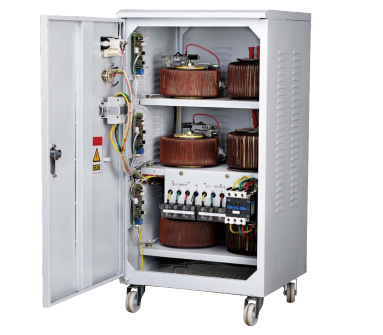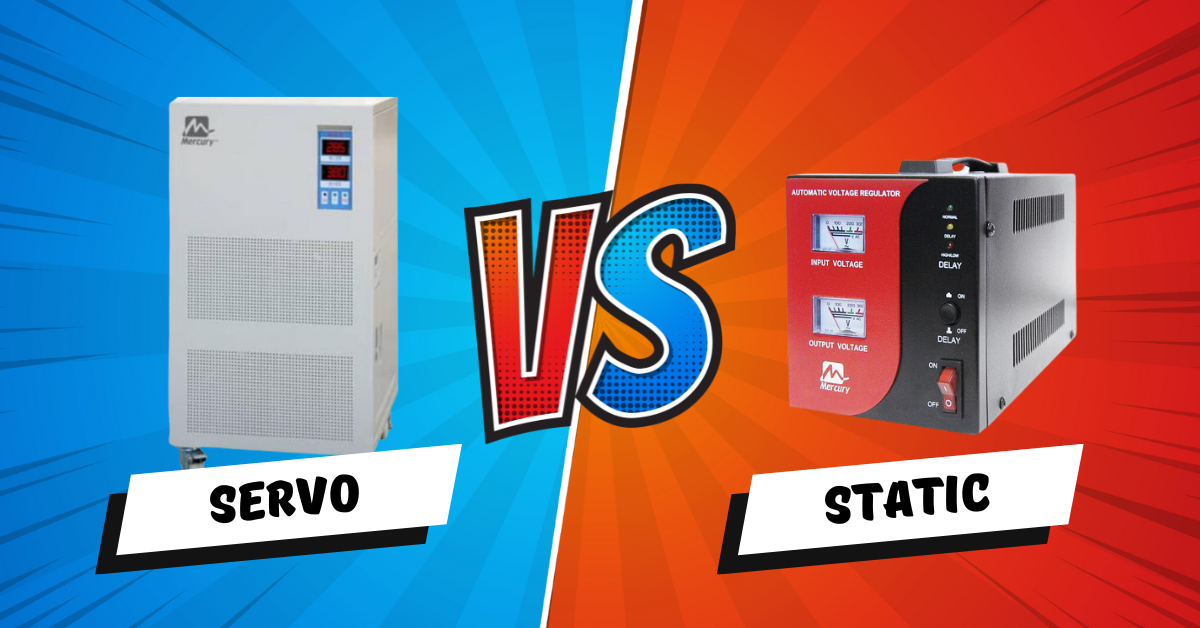Servo vs Static Voltage Stabilizers: Which is Better for Regulating Voltage Fluctuations?
Voltage stabilizers have become essential to regulate voltage supplied to electrical appliances. But which type of stabilizer is better - servo or static? This comprehensive guide compares servo vs static stabilizers, explaining their working principle, pros/cons, and applications to help you choose the right voltage stabilization system.
What is a Voltage Stabilizer and Why Do You Need One?

A voltage stabilizer is an electrical device used to stabilize voltage and maintain a constant voltage output despite fluctuations in input voltage. It protects connected equipment from damage due to voltage surges or drops.
Voltage stabilizers are commonly used to regulate the AC mains voltage supply to electrical appliances and electronics. They ensure a constant voltage output and compensate for problems like:
- Voltage fluctuations - frequent variations in input voltage
- Over-voltages - voltage spikes that can destroy equipment
- Under-voltages - drops in voltage that can disrupt functioning of appliances
Without a good stabilizer, voltage fluctuations can decrease the lifespan of your appliances, cause performance issues, or even permanently damage them. That's why voltage stabilizers have become essential for homes and offices to safeguard electrical equipment.
Types of Voltage Stabilizers: Servo vs Static
There are two main types of voltage stabilizers - servo stabilizers and static stabilizers. Both work on the same basic principle of voltage regulation but have some key differences.
What is a Servo Stabilizer?
A servo stabilizer, also known as servo voltage stabilizer, uses a servo motor to correct output voltage. It's called a servo stabilizer because it uses a servo mechanism for smooth voltage stabilization.
The servo motor controls the shaft of the autotransformer. When input voltage fluctuates, the servo motor rotates the autotransformer shaft to adjust the output voltage. This enables continuous and smooth compensation against voltage variations.
Servo stabilizers provide excellent line and load voltage regulation. They have fast response times in milliseconds to correct voltage deviations. Servo types offer high accuracy with output voltage control within ±10 V.
What is a Static Stabilizer?
A static stabilizer, also known as static voltage stabilizer, uses electronic circuits and does not contain any moving parts. It monitors the input AC voltage and uses buck-boost transformers and other components to adjust the output voltage.
When the input voltage increases above a preset limit, the buck transformer steps down the voltage. When the input voltage decreases below the limit, the boost transformer steps up the output voltage. This allows the stabilizer to maintain a constant output voltage.
Static stabilizers provide decent voltage regulation but slower response times ranging from a few milliseconds to seconds. They have lower accuracy around ±20 V but cost significantly lesser than servo types.
Working Principle of Servo vs Static Stabilizers
Now let's understand how servo and static stabilizers work to regulate voltage:
Servo Voltage Stabilizer Working
A servo stabilizer uses a built-in reference voltage source, an error detector, and a servo motor mechanism. Here are the key steps:
- The input voltage to be stabilized is fed to the regulator circuit.
- This circuit continuously compares the output voltage with the built-in reference voltage.
- When fluctuations occur, the error detector circuit computes the difference and generates an error signal.
- This error signal is amplified and fed to the servo motor.
- The servo motor then rotates the autotransformer shaft to adjust the output voltage and reduce the error.
- This negative feedback loop ensures the output voltage remains constant despite input variations.
The servo mechanism enables smooth and fast correction of voltage. As soon as the input voltage changes, the servo motor immediately corrects the output voltage.
Static Voltage Stabilizer Working
A static stabilizer works in the following way:
- The input supply voltage is provided to the sensing and controlling circuits.
- The control circuit continuously compares the output voltage with a reference voltage.
- When the input voltage increases above the preset limit, power electronic devices reduce the output voltage.
- If input voltage decreases below the limit, the circuits boost the output voltage accordingly.
- This ON/OFF switching is used to maintain a constant output voltage.
Static stabilizers provide step-wise voltage correction by switching between different transformer taps. The response is slower than servo types but adequate for basic voltage stabilization.
Servo vs Static Stabilizer: Key Feature Comparison
Now that you understand their working, let's compare the main features of servo vs static stabilizers:
| Parameter | Servo Stabilizer | Static Stabilizer |
|---|---|---|
| Voltage Regulation | Excellent (±10 V) | Good (±20 V) |
| Response Time | Very fast (under 1 second) | Moderate (up to few seconds) |
| Correction Method | Smooth and continuous | Stepped regulation |
| Energy Efficiency | High | Moderate |
| Voltage Range | Limited voltage taps | Wider voltage range |
| Mechanism | Complex, moving parts | Simple, no moving parts |
| Noise | No sound | Relay switching noise |
| Cost | Expensive | Affordable |
| Size | Bulkier | Compact |
| Maintenance | Requires Service | Low maintenance |
| Lifespan | Around 25 years | Over 10 years |
| Applications | Sensitive devices, labs | Home appliances, offices |
As seen above, servo voltage stabilizers are faster, more accurate, efficient, and compact. But they come at a higher cost and require maintenance.
Static stabilizers are cheaper, simpler, and more durable. But they have lower accuracy and slower response. They are good enough for basic home/office applications.
Frequently Asked Questions on Servo vs Static Stabilizers
1. What is a stabilizer?
A stabilizer is a device used to regulate and control the voltage supplied to electrical equipment in order to maintain a constant voltage output.
2. What is a servo stabilizer?
A servo stabilizer is a type of stabilizer that uses a servo motor and an electronic control circuit to continuously monitor and adjust the voltage to maintain a stable output voltage level.
3. What is the difference between a servo stabilizer and a static stabilizer?
The main difference between a servo stabilizer and a static stabilizer lies in the method used to regulate the voltage. A servo stabilizer uses a servo motor and an electronic circuit, while a static stabilizer uses a relay or other static components. The servo stabilizer offers better voltage correction speed and accuracy compared to a static stabilizer.
4. What is voltage fluctuation?
Voltage fluctuation refers to the variation in the supplied voltage that can occur due to factors such as load changes, power surges, or faults in the electrical system. These fluctuations can be harmful to electrical equipment.
5. What is the purpose of voltage correction in stabilizers?
The purpose of voltage correction in stabilizers is to regulate and stabilize the voltage supplied to electrical equipment, ensuring a constant voltage output even when there are fluctuations in the incoming voltage.
6. What are the different types of stabilizers?
There are mainly two types of stabilizers: servo stabilizers and static stabilizers. Servo stabilizers use a servo motor, while static stabilizers use static components like relays or electronic circuits.
7. What is an automatic voltage regulator?
An automatic voltage regulator is a device that automatically regulates and stabilizes the voltage supplied to electrical equipment. It can ensure a constant voltage output despite fluctuations in the input voltage.
8. How does a servo stabilizer work?
A servo stabilizer works by continuously monitoring the voltage using a control circuit. If there are any variations in the input voltage, the servo motor adjusts the voltage using a buck-boost transformer to correct and stabilize the output voltage.
9. What are the advantages of using a servo stabilizer?
Some advantages of using a servo
Here are some common questions answered on servo vs static voltage stabilizers:
- Smooth and continuous voltage correction
- Fast response times
- High accuracy
- Effective at stabilizing both high and low voltage deviations
Conclusion: Choose the Right Voltage Stabilizer for Your Needs
- Servo stabilizers offer excellent precision control while static types provide cost-effective basic stabilization.
- For critical loads and sensitive electronics, invest in a servo stabilizer for robust protection.
- For general home/office use, a static stabilizer gives adequate voltage regulation at lower cost.
- Ensure proper sizing, installation and maintenance for long-lasting voltage stabilization.
With this detailed comparison of servo vs static voltage stabilizers, you can make an informed choice based on your requirements. Install high-quality stabilizers to safeguard your valuable electrical appliances and electronics from voltage fluctuations.

